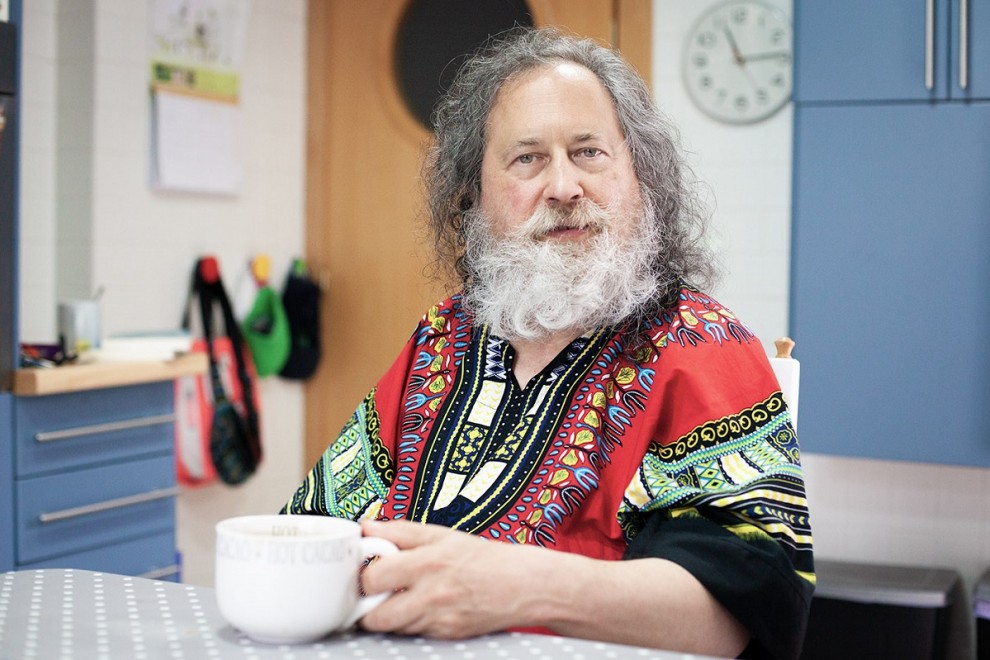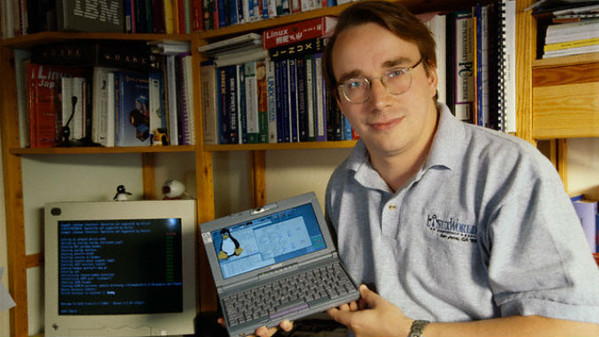Open source started with the free software foundation, founded to defend the rights and freedoms of software users. Today, open source software is being used and developed by billions of individuals, and across all industries.
Just like the free software foundation that inspired the more pragmatic open source movement, Bitcoin too started as an ideologically-driven project, and is now on the path of mainstream acceptance.
Bitcoin’s development has been influenced by the open source movement in many ways, and indeed would have not been possible without it. The history and achievements of the open source movement can inform how Bitcoin might grow and evolve in the future.
GNU and the free software movement
From the 1950s, software was commonly shared freely between users. For hardware manufacturers, having to provide software and documentation with their machines was costly, and they welcomed the fact that users wished to write and distribute programs for their machines for free. But by the early seventies, the growing computer software industry began to distribute their programs in the form of binary executables, and restricted users from accessing or modifying the source code, preventing students and engineers from studying and improving them.
Richard Stallman, then a programmer at the Artificial Intelligence Laboratory of the MIT, believed these practices were unethical, and hindered progress in computer science. In September 1983, he announced the GNU free software project. At that time, the most advanced and compatible computer operating system was UNIX, developed by AT&T Bell Labs. The goal of the GNU project was to develop a completely non-proprietary UNIX-compatible operating system, along with a full suite of customizable applications.

Once GNU is written, everyone will be able to obtain good system software free, just like air . This means much more than just saving everyone the price of a Unix license. It means that much wasteful duplication of system programming effort will be avoided. This effort can go instead into advancing the state of the art.
Initial Announcement of the GNU Project – Richard Stallman
In the GNU manifesto, Stallman encouraged other programmers to contribute work to the project, and wrote the GNU General Public License to protect the rights of users and developers. In 1985, he started the Free Software Foundation, a non-profit that aims at supporting free software development, and eliminating the need for all proprietary software by developing free compatible alternatives. The word “free” in free software refers not to price, but individual freedom. The FSF defines software as free if the users have the four essential freedoms:
- The freedom to run the program as you wish, for any purpose (freedom 0).
- The freedom to study how the program works, and change it so it does your computing as you wish (freedom 1). Access to the source code is a precondition for this.
- The freedom to redistribute copies so you can help others (freedom 2).
- The freedom to distribute copies of your modified versions to others (freedom 3). By doing this you can give the whole community a chance to benefit from your changes. Access to the source code is a precondition for this.
Stallman’s efforts with GNU and the FSF would lay the legal, technological and philosophical groundwork for the free software movement.
GNU/Linux
In the early 1990s, the GNU project had developed most of the programs needed in an operating system but was still missing a kernel—the core of the operating system responsible for allocating resources. Linus Torvald, a computer science student at the University of Helsinki, had developed a working kernel as a hobby, which he published under the GNU General Public License in 1992. The kernel, combined with the existing GNU packages, brought about the first operating system completely free of closed licenses: Linux.

Early releases of Linux were shared between users and quickly became popular. Linux was able to grow a large community of testers, developers, and users thanks to the mainstream adoption of personal computers and the rapid growth of the internet. Apache, a free Linux-based web server program, gained market share after being recognized for its versatility, safety, and cost efficiency. This gave a lot of the new web companies an incentive to run Linux instead of proprietary software such as Windows, and companies like Red Hat appeared to provide services around free software such as support, consulting and optimization, challenging the notion that the only viable business model for software companies is to sell closed, proprietary software.
The browser wars
In the nineties, two browsers were competing for market share: Microsoft’s Internet Explorer and Netscape Communicator. Netscape was an internet-technology company whose main business was to sell servers and web services. Microsoft, who had a monopoly position in the PC market, started bundling Internet Explorer with their operating system Windows, and made it hard for users to use a different browser, practices for which the US government later tried the company in an antitrust case.

By taking over the browser market, Microsoft could influence web standards, which needed to stay open in order for the web to remain a freely-available public resource. Netscape’s business would be under threat if Microsoft succeeded in turning the Web protocol’s open standards into proprietary ones.
After intense internal debates, Netscape decided to make the source code of their browser, now called Mozilla, freely available, and later started the Mozilla Foundation to support open web standards. This decision brought a lot of mainstream attention to the idea of free software and of a neutral, open internet.
Open-source rebranding
Netscape’s decision to make their browser’s source freely available was a pragmatic rather than ideological one. As free software was starting to gain traction, some members of the community felt that the term free software could be a barrier to adoption for some businesses and potential allies, as it could be associated with poor quality, or with the Free Software Foundation’s definition and philosophical implications.
Members of the community came together to invent a new term which would better describe the movement. They wanted to put forward the idea that the software was open and the source code available, and landed on the name open source, which they considered to be a more palatable marketing term to achieve their goal of making free and open software mainstream.
While the open-source movement focuses on the pragmatic advantages of open collaboration, Richard Stallman and the Free Software Foundation consider the moral arguments for user freedom and against intellectual property to be more important, and continue to support free software, but today the terms are mostly being used interchangeably.
Advantages of open-source
In general, the more widely available the source code is for public scrutiny, the more rapidly all kinds of bugs and security issues will be discovered. Eric Raymond, open source advocate and author of the 1999 book The Cathedral and the Bazaar, formulated Linus’s Law, which describes this phenomena:
Given enough eyeballs, all bugs are shallow. A more formal statement is: “Given a large enough beta-tester and co-developer base, almost every problem will be characterized quickly and the fix obvious to someone.”
In his book, Raymond describes the bazaar style of bottom-up, peer-to-peer and distributed development process of an open-source project, and highlights that in most cases, the supposed advantages of the conventional closed, top-down and hierarchical cathedral style are outstripped by having constant independent peer review.
Another advantage of open-source is its scalability. Adding extra developers to a closed-source projects does not necessarily lead to an increase in productivity, as developer onboarding time, increased project management requirements and inefficient allocation of tasks can lead to software development taking longer.
Open-source contributors self-select for tasks according to their expertise, and contributions are selected based on their quality, rather than internal company politics. These contributors, driven by their passion for solving a problem they find interesting, are often more efficient than teams of developers sitting at a desk who would rather be doing something else.

Open source promises higher quality, better reliability, greater flexibility, and lower costs, unlike proprietary lock-ins where individuals and entire companies can be held hostage by their software provider for support and upgrades. It allows us to build upon and extend existing open projects instead of duplicating closed-source efforts, leading to more effort being devoted to advancing technology.
Open source money
“A lot of people automatically dismiss e-currency as a lost cause because of all the companies that failed since the 1990s. I hope it’s obvious it was only the centrally controlled nature of those systems that doomed them. I think this is the first time we’re trying a decentralized, non-trust-based system.”
Satoshi Nakamoto on P2P Foundation
Up until the launch of Bitcoin in 2009, monetary systems and currencies have been monopolized by nations and central banks, who have systematically used legal and physical force to crush competitors. Users have had no choice but to use private fiat currencies as money, and were at the mercy of rampant inflation, abrupt changes in monetary policy, arbitrary seizure and censorship, and an inefficient digital payment infrastructure that results in high fees.
Bitcoin is the first open source monetary network. It is developed and maintained collaboratively, and much of the software ecosystem around it is also open source. The network is decentralized—which means that it is run by its users, who are able to use it to send each other units of value in a peer-to-peer way.
Being open and public was necessary for the success of an alternative monetary network; previous ones such as Liberty Reserve or E-Gold failed because of their centralized design which made them easy to pressure and shut down. The many unsuccessful attempts to ban it proves that Bitcoin is now too big and spread out to be disrupted by governments. Similarly, the Blocksize War showed that corporations or other entities cannot co-opt Bitcoin, and that changing its rules simply results in a fork, which is harmless to users.
The promise of open source is to offer better alternatives to proprietary tools. Bitcoin as a public infrastructure for money can offer features that are impossible to provide for a private fiat currency:
- The network verifies transactions using cryptographic signatures instead of personal information. Anyone with an internet connection can use it in a permissionless way, and protect their privacy.
- Bitcoin’s monetary policy is fixed and therefore protects savers from inflation caused by arbitrary debasement by a central bank.
- Bitcoin is global and therefore has the potential to have a much bigger user base and network effect than any single private currency.
- Bitcoin is fully transparent and auditable. No one has any special permissions, and there is no way to make a fraudulent transaction.
- Banks and centralized payment networks can be hacked or disrupted. Bitcoin is secure, open 24/7, and does not shut down for maintenance.
- Bitcoin is public and interoperable, which allows for unbounded innovation in payments, and integration with any app, website or network.
Bitcoin has the potential to revolutionize money in the same way that open source revolutionized software, challenging the monopoly held by nations and central banks over the monetary system.
Revolution OS (documentary about GNU/Linux)
Posted at block 800361





Leave a comment